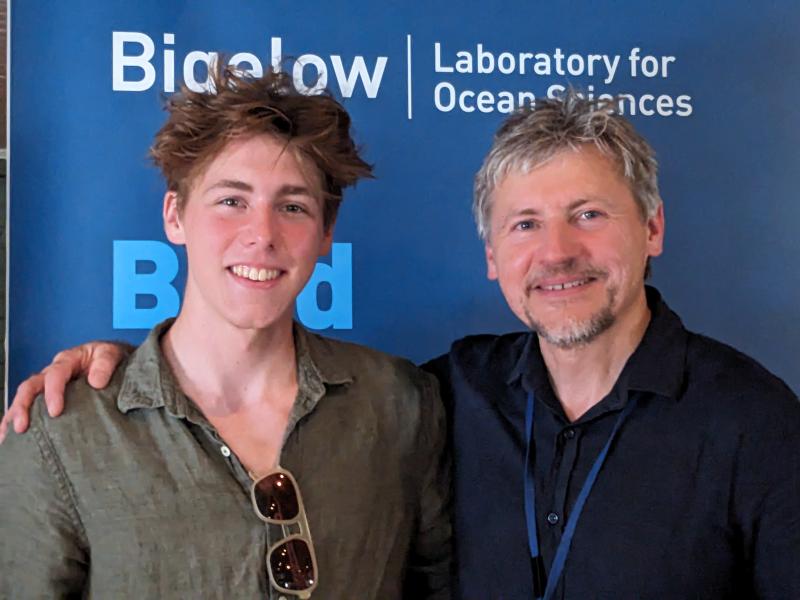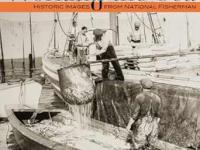Bigelow’s Cafe Sci lecture takes on single cell genomics
 Third lecture in the Café Sci series, “Single Cell Genomics: Understanding the Ocean’s Potential, One Cell at a Time” at the Opera House of Boothbay Harbor. CANDI JONETH/Boothbay Register
Third lecture in the Café Sci series, “Single Cell Genomics: Understanding the Ocean’s Potential, One Cell at a Time” at the Opera House of Boothbay Harbor. CANDI JONETH/Boothbay Register
 Ramunas Stepanauskas, Ph.D., senior research scientist and Director of the Single Cell Genomics Center at Bigelow Laboratory for Ocean Sciences. CANDI JONETH/Boothbay Register
Ramunas Stepanauskas, Ph.D., senior research scientist and Director of the Single Cell Genomics Center at Bigelow Laboratory for Ocean Sciences. CANDI JONETH/Boothbay Register
 Jonas Stepanauskas, left, was recognized by his father during the lecture. Jonas recently graduated from Lincoln Academy and plans to study engineering in college. CANDI JONETH/Boothbay Register
Jonas Stepanauskas, left, was recognized by his father during the lecture. Jonas recently graduated from Lincoln Academy and plans to study engineering in college. CANDI JONETH/Boothbay Register
 Ramunas Stepanauskas. CANDI JONETH/Boothbay Register
Ramunas Stepanauskas. CANDI JONETH/Boothbay Register
 CANDI JONETH/Boothbay Register
CANDI JONETH/Boothbay Register
 Third lecture in the Café Sci series, “Single Cell Genomics: Understanding the Ocean’s Potential, One Cell at a Time” at the Opera House of Boothbay Harbor. CANDI JONETH/Boothbay Register
Third lecture in the Café Sci series, “Single Cell Genomics: Understanding the Ocean’s Potential, One Cell at a Time” at the Opera House of Boothbay Harbor. CANDI JONETH/Boothbay Register
 Ramunas Stepanauskas, Ph.D., senior research scientist and Director of the Single Cell Genomics Center at Bigelow Laboratory for Ocean Sciences. CANDI JONETH/Boothbay Register
Ramunas Stepanauskas, Ph.D., senior research scientist and Director of the Single Cell Genomics Center at Bigelow Laboratory for Ocean Sciences. CANDI JONETH/Boothbay Register
 Jonas Stepanauskas, left, was recognized by his father during the lecture. Jonas recently graduated from Lincoln Academy and plans to study engineering in college. CANDI JONETH/Boothbay Register
Jonas Stepanauskas, left, was recognized by his father during the lecture. Jonas recently graduated from Lincoln Academy and plans to study engineering in college. CANDI JONETH/Boothbay Register
 Ramunas Stepanauskas. CANDI JONETH/Boothbay Register
Ramunas Stepanauskas. CANDI JONETH/Boothbay Register
 CANDI JONETH/Boothbay Register
CANDI JONETH/Boothbay Register
Ramunas Stepanauskas, Ph.D., senior research scientist and director of the Single Cell Genomics Center (SCGC) at Bigelow Laboratory for Ocean Sciences (BLOS), delivered the third lecture in the Café Sci series, “Single Cell Genomics: Understanding the Ocean’s Potential, One Cell at a Time,” at the Opera House of Boothbay Harbor July 30, to a crowd of about 140 people. “He is a real visionary. We (BLOS) have a lot of impressive scientists and he stands out among them,” said Deborah Bronk, BLOS president and CEO, in her introduction.
Stepanauskas, like his Café Sci predecessors, offered photos of himself growing up in 1974 (the year BLOS was founded) in Lithuania, where the closest body of water to him was the Baltic Sea. He attended college in Sweden, first at Uppsala University, before being awarded his Ph.D. in ecology from Lund University. A post-doctoral fellowship at the University of Georgia opened his eyes to how little could be accomplished with modern scientific tools and set him on his current path at BLOS, where he and his team develop state-of-the-art tools to study microscopic organisms. He has studied microbes (that stopped evolving millions of years ago) trapped in water in isolated mines of South Africa, and he has helped NASA detect microbial contamination on spacecraft, but microbial life in the ocean has proven to be his career’s focus. “In the ocean, most life is microscopic – tiny in size, but their numbers are astronomical,” he said.
“Although invisible to the naked eye, the microbes I study are so numerous and diverse that they play major roles in the uptake of atmospheric carbon dioxide, soil fertility, plant and animal health, and countless aspects of the modern bioeconomy. However, only a tiny fraction of the planet’s microbial diversity is amenable to cultivation, a necessity for traditional research techniques,” he writes in Transect (Summer 2024).
In 2009, with the founding of SCGC – the world’s first facility for studying DNA in individual microbial cells – Stepanauskas and his team developed technologies that have mapped biological blueprints of individual microbes, bypassing the need for lab cultivation. Over the next 50 years, Stepanauskas predicts these technologies will cost less, be more scalable, and be applied to a larger scope of scientific inquiry.
His tools help scientists understand how microbes evolve, what they use as energy sources, and can even measure the rate of respiration in a cell’s genome. His group is centered on connecting a cell’s genome with its biological functions, a knowledge gap that has long evaded scientists. Some of his discoveries have been possible through the use of flow cytometry (FC), as presented in the prior Café Sci by Nicole Poulton, though his research of environment micro-compartment genomics is too small to be picked up by FC and this is where his work in developing tools and technologies through SCGC, along with a partnered start-up company, is today. They have a patent pending to apply this technology to virus-tracking in humans.
“The work here in Boothbay helps us understand implications all over the world,” he said. “SCGC’s services are available to the global scientific community and have been used by over 100 organizations and companies on six continents,” he writes.
As for the next steps, “I’d like to be awarded a grant to expand our research into an offshore, larger environment,” he said.
Stepanauskas’ lecture will be posted on BLOS’s YouTube channel. The series of lectures, sponsored by HM Payson, have built upon themselves in both looking back over BLOS’s 50-year legacy of scientific advancement and in helping the audience understand the science of today. The series concludes Aug. 6 with “Satellite Oceanography: Unlocking Insights by Analyzing the Big Picture,” by senior research scientist Catherine Mitchell, as she looks to unify the content of the prior lectures into a synoptic design that informs BLOS’s approach to research.
Space is limited, and free registration is required.


































